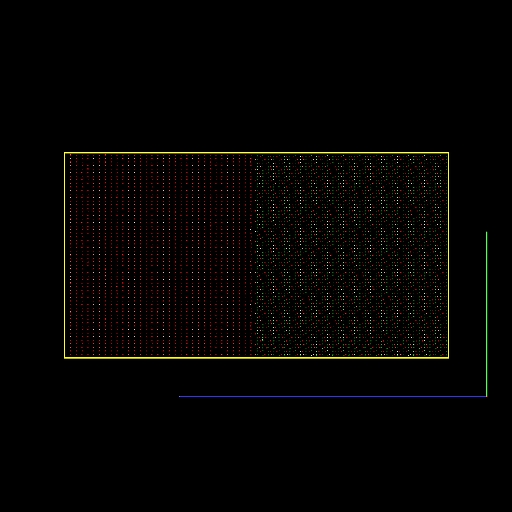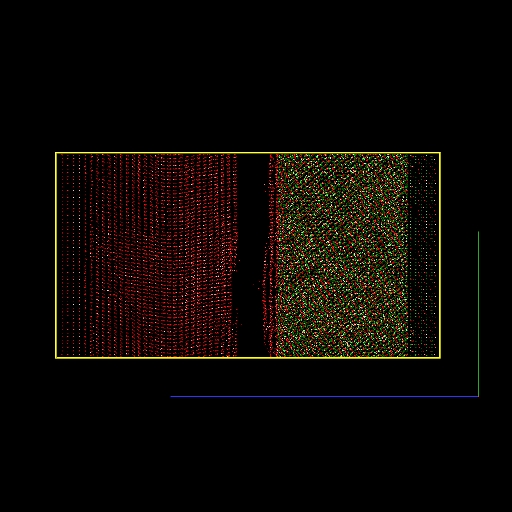Dear all
I am studying, interaction of tow material interface normal to Z direction. I used “P P S” condition. I need to allow the end of this tow materials (boundary) move in z direction when the opposite faces of these materials are interact with each other in z direction. I need the atoms in boundary group that are in a plane should remain in a plane during simulation and moving in Z direction. I used the “fix bforce boundary setforce 0 0 NULL”, but it couldn’t do it.
please help me.
Thanks
Hadi
Dear all
I am studying, interaction of tow material interface normal to Z direction.
I used "P P S" condition. I need to allow the end of this tow materials
(boundary) move in z direction when the opposite faces of these materials
are interact with each other in z direction. I need the atoms in boundary
group that are in a plane should remain in a plane during simulation and
moving in Z direction. I used the "fix bforce boundary setforce 0 0 NULL",
but it couldn't do it.
of course, this cannot work. if you want to have atoms in a group to
stay in a plane, it doesn't matter what you do to the force in x- and
y-direction, but it matters a lot, what you do in the z-direction. try
fix aveforce with NULL NULL 0.0 instead (or in addition if you really
must freeze out the movement in x- and y-direction).
axel.
Dear Axel
I used “fix boundryforce boundary setforce 0.0 0.0 NULL” and " fix baveforce boundary aveforce NULL NULL 0" together. because of the adhesion in interface of tow materials, the boundary must move in Z direction (shrink) and so I want the atoms in boundary that are in a plane, remain in the plane during relaxation. but in my simulation (relaxation) the boundary don’t move ( attached pics) and behave such as when I used “fix boundryforce boundary setforce 0.0 0.0 0.0” command. this cause the simulation box ruptured due to the increased tension in the simulation box.(attached pic)
please help me how I can do that?
Thanks


Dear Axel
I used "fix boundryforce boundary setforce 0.0 0.0 NULL" and " fix baveforce
boundary aveforce NULL NULL 0" together. because of the adhesion in
interface of tow materials, the boundary must move in Z direction (shrink)
and so I want the atoms in boundary that are in a plane, remain in the plane
during relaxation. but in my simulation (relaxation) the boundary don't move
( attached pics) and behave such as when I used "fix boundryforce boundary
setforce 0.0 0.0 0.0" command. this cause the simulation box ruptured due to
the increased tension in the simulation box.(attached pic)
please help me how I can do that?
how should i be able to do that? i don't have a crystal ball and
cannot read minds (of people or computers). if you do your simulations
correctly, it will work. there are far too many ways how you can mess
things up. the only advice i can give is to build and debug your input
deck step by step and identify the problematic parts. at this point,
you are on your own. it is your project, not mine.
axel.
Dear Axel
I apologies for bothering you with my questions. maybe I couldn’t explain my question very good or I have basically error to understand the “fix setforce” & “fix aveforce” commands.
I know when I set a velocity to boundary with setforce 0.0 the atoms will move with this velocity. but I don’t know if in relaxation mode with “nve” command and initial velocity for boundary equal zero, when I used “fix boundryaveforce boundary aveforce NULL NULL 0.0”, the boundary atoms can move due to extension of the other atoms or not.
I used a simple input script and there is in the following. I hope I could explain the problem.
Thanks
units metal
dimension 3
atom_style atomic
boundary p p s
read_data simatoms.data
pair_style meam
pair_coeff * * library.meam Fe O FeO.meam Fe O
thermo 10
thermo_style custom step pe vol temp lz
timestep 0.0002
min_style cg
minimize 1.0e-10 1.0e-10 1000 1000
replicate 4 4 4
variable bound equal 5
variable tmp1 equal lz
variable topz equal {tmp1}-{bound}
variable bottomz equal ${bound}
region upper block INF INF INF INF {topz} INF units box
region lower block INF INF INF INF INF {bottomz} units box
group lower region lower
group upper region upper
group boundary union lower upper
group mobile subtract all boundary
velocity mobile create 500.0 234 dist gaussian
fix 1 all nve
fix boundryforce boundary setforce 0.0 0.0 NULL
fix boundryaveforce boundary aveforce NULL NULL 0.0
run 100000
Dear Axel
I apologies for bothering you with my questions. maybe I couldn't explain my
question very good or I have basically error to understand the "fix
setforce" & "fix aveforce" commands.
I know when I set a velocity to boundary with setforce 0.0 the atoms will
move with this velocity. but I don't know if in relaxation mode with "nve"
command and initial velocity for boundary equal zero, when I used "fix
boundryaveforce boundary aveforce NULL NULL 0.0", the boundary atoms can
move due to extension of the other atoms or not.
the commands work fine, if used correctly.
I used a simple input script and there is in the following. I hope I could
this is unusable, since nobody can run this without having the missing
files. if you don't want to provide your own data, modify an example
input, e.g. the "melt" example.
explain the problem.
Thanks
[...]
region upper block INF INF INF INF \{topz\} INF units box region lower block INF INF INF INF INF {bottomz} units box
group lower region lower
group upper region upper
group boundary union lower upper
group mobile subtract all boundaryvelocity mobile create 500.0 234 dist gaussian
fix 1 all nve
fix boundryforce boundary setforce 0.0 0.0 NULL
fix boundryaveforce boundary aveforce NULL NULL 0.0
this, of course, *cannot* work. if you average the force over both
sides what do you expect as resulting force to be averaged?
but that also doesn't explain how your walls get busted. you must be
doing something else wrong. it works for me.
axel.